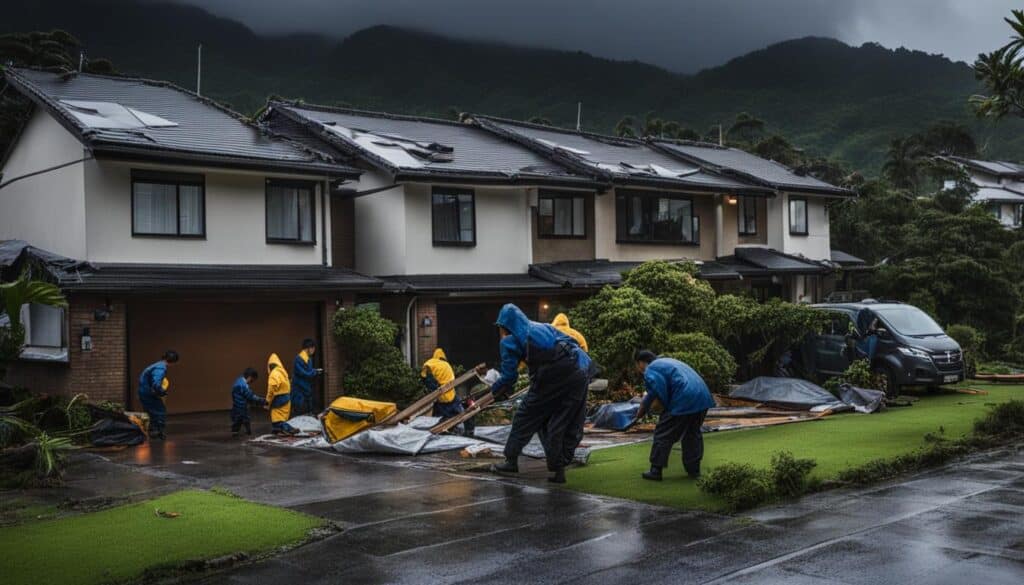The Hong Kong Observatory (HKO) issues tropical cyclone warning signals to alert the public about the current typhoon conditions. The warning symbols indicate the status of the typhoon, with a red flashing rectangle indicating an active warning, and a symbol without the red flashing rectangle indicating a canceled warning. The HKO provides real-time updates on the issue and cancellation times of the warning signals.
Key Takeaways:
- Stay updated with the typhoon signals issued by the Hong Kong Observatory.
- Take necessary precautions and ensure personal safety during typhoon conditions.
- Follow the instructions and guidelines provided by local authorities.
- Prepare an emergency kit with essential supplies in advance.
- Cooperate with community organizations and engage in typhoon preparedness efforts.
Hong Kong Typhoon Signals and Warnings
The Hong Kong Meteorological Department plays a crucial role in providing timely and accurate information regarding typhoon signals and warnings to the public. These signals, ranging from T1 to T10, are vital for residents to understand the severity of an approaching typhoon and take necessary precautions. The public warning system, implemented by the Hong Kong Meteorological Department, ensures that residents are well-informed and prepared for any potential impact.
The typhoon signals serve as a guide for residents to gauge the intensity of the approaching typhoon. The higher the signal number, the stronger the anticipated impact. When a typhoon signal is raised, the public is advised to stay updated with the latest information, closely monitor the situation, and follow the instructions and guidelines provided by the local authorities. It is essential to remain vigilant and take necessary safety measures to protect oneself and one's property.
The Hong Kong Meteorological Department continuously monitors the movement of typhoons and provides regular updates on the signal status. Residents can access these updates through various channels, including real-time weather apps, news broadcasts, and the official website of the Hong Kong Meteorological Department. Staying informed about the typhoon signals ensures that individuals can make informed decisions and respond effectively to mitigate any potential risks or hazards.
| Typhoon Signal Level | Implications |
|---|---|
| T1 | Standby signal; the typhoon is moving towards Hong Kong, and there is a possibility of strong winds. |
| T3 | Stronger winds; residents should take precautions and secure loose objects. |
| T8 | Powerful typhoon with strong winds; businesses and schools may be suspended, and residents should stay indoors. |
| T10 | The highest signal level indicating a severe typhoon; all essential services are affected, and residents should stay indoors until the signal is lowered. |
It is important to note that typhoon signals can change rapidly based on the trajectory and intensity of the typhoon. Therefore, residents are advised to stay tuned to the updates provided by the Hong Kong Meteorological Department to ensure their safety and well-being during typhoon events .
Importance of Stay Updated with Typhoon Signals
Staying updated with typhoon signals is crucial for emergency preparedness and effective disaster management in Hong Kong. Real-time weather updates and accurate information on the typhoon's movement play a vital role in assisting authorities in making informed decisions regarding public safety measures.
During a typhoon, it is important for residents to stay informed about the current typhoon signal to take necessary precautions and ensure their safety. By knowing the status and intensity of the typhoon, individuals can make informed decisions about evacuation, securing their homes, and stocking up on essential supplies.
“Staying updated with typhoon signals is crucial for emergency preparedness and effective disaster management in Hong Kong.”
The Role of Real-Time Weather Updates
Real-time weather updates provide accurate and timely information on the typhoon's movement, intensity, and potential impact. By utilizing technology and meteorological data, authorities are able to monitor the typhoon's progress and issue timely warnings to the public. This helps residents stay informed and make informed decisions regarding their safety.
Emergency Preparedness and Response
Being aware of the current typhoon signal allows residents to be prepared and respond effectively during a typhoon. Emergency preparedness Measures, such as securing loose objects, stocking up on food and water supplies, and having a contingency plan in place, can all be implemented based on the information provided by the typhoon signals.
Hong Kong Disaster Management
The Hong Kong government places great emphasis on disaster management and preparedness. The typhoon signals serve as a critical component of their disaster management strategy, enabling them to effectively allocate resources, implement evacuation plans, and coordinate emergency services. Keeping the public updated with the current typhoon signal is a key aspect of their efforts to protect the safety and well-being of residents.
| Benefits of Staying Updated with Typhoon Signals | Actions to Take Based on Typhoon Signals |
|---|---|
| 1. Timely warnings to evacuate high-risk areas | 1. Secure loose objects in and around your home |
| 2. Accurate information on the typhoon's intensity and potential impact | 2. Stock up on essential supplies like food, water, and medication |
| 3. Enable effective coordination of emergency services | 3. Develop a contingency plan for your family |
Staying updated with typhoon signals is not only essential for personal safety but also for the overall disaster management efforts in Hong Kong. By actively monitoring and following the typhoon signals, residents can contribute to a more resilient and prepared community.
Impact of Typhoons on Hong Kong
Typhoons have a significant impact on Hong Kong, causing strong winds, heavy rainfall, and potential flooding. These weather conditions can lead to disruptions in transportation, power outages, and damage to infrastructure. The Hong Kong Observatory tracks the path and intensity of typhoons to provide timely warnings and help mitigate the impact on the city.
Typhoons in Hong Kong are characterized by their strong winds, which can reach speeds of up to 180 kilometers per hour. These powerful gusts pose a threat to buildings, trees, and other structures, leading to potential damage and destruction. In addition, the heavy Rainfall associated with typhoons can result in widespread flooding, especially in low-lying areas and coastal regions.
The impact of typhoons on Hong Kong's infrastructure is significant. The city's transportation system, including roads, bridges, and airports, can be severely affected, leading to delays and disruptions in travel. Power outages are also common during typhoons as strong winds and debris falling damage power lines and infrastructure. The Hong Kong government and utility companies work diligently to restore services as quickly as possible to minimize inconvenience to residents.
| Impact of Typhoons on Hong Kong | Examples |
|---|---|
| Disruptions in transportation | Flights canceled, roads flooded, and ferry services suspended. |
| Power outages | Homes and businesses without electricity for hours or even days. |
| Damage to infrastructure | Fallen trees, collapsed buildings, and damaged roads and bridges. |
| Flooding | Low-lying areas and coastal regions submerged in water. |
| Loss of life and injuries | People affected by flying debris, flooding, or structural collapses. |
Despite the potential dangers, the Hong Kong government and the public have gained valuable experience in managing and mitigating the impact of typhoons throughout the years. Strict building codes and regulations ensure that structures are built to withstand strong winds, and comprehensive evacuation plans are in place to ensure the safety of residents in high-risk areas.
"Typhoons are a natural part of Hong Kong's weather system, and the city has developed measures to safeguard its residents and infrastructure against their impact." – Hong Kong Meteorological Department
By closely tracking the path and intensity of typhoons, the Hong Kong Observatory can provide accurate and timely warnings to the public, allowing individuals and businesses to make necessary preparations and take precautions. The government works hand in hand with various agencies and organizations to ensure a swift and coordinated response to typhoon events, minimizing the impact on the community.
Typhoon Safety Precautions and Hong Kong Disaster Management
When a typhoon is approaching, it is crucial for residents in Hong Kong to take safety precautions and be aware of the disaster management measures in place to protect their well-being. The Hong Kong government has implemented a comprehensive response system that includes various preparedness measures to ensure the safety of the public.
Public Safety Guidelines during Typhoons
During a typhoon, residents are advised to stay indoors and avoid unnecessary travel. Securing loose objects and reinforcing windows and doors are essential to minimize potential damage caused by strong winds. It is also recommended to stock up on essential supplies such as food, water, and medications in case of any disruptions in services.
“Staying informed and following the instructions issued by local authorities is of utmost importance during a typhoon.” – Hong Kong Disaster Management Department
In addition to personal safety precautions, the Hong Kong government plays a significant role in disaster management by issuing evacuation orders for high-risk areas and setting up temporary shelters for those in need. Emergency services are deployed promptly to ensure the safety and well-being of residents.
Table: Hong Kong Disaster Management Measures
| Type of Measure | Description |
|---|---|
| Evacuation Orders | Issued for high-risk areas to ensure the safety of residents |
| Temporary Shelters | Provided for individuals who need a safe place to stay during the typhoon |
| Emergency Services | Deployed to assist residents in case of emergencies or immediate assistance |
| Safety Guidelines | Issued to guide the public on necessary safety measures during a typhoon |
By following these safety precautions and cooperating with the efforts of Hong Kong's disaster management department, residents can ensure their safety and minimize the impact of typhoons on their lives. It is essential to stay informed and act responsibly to protect oneself and the community during severe weather conditions.

Public Safety Measures During Typhoons
The Hong Kong government places utmost importance on public safety during typhoons, recognizing the need for proactive measures to protect residents from potential hazards. In line with this, the government has implemented various guidelines and recommendations to ensure the well-being of the community.
Emergency Preparedness
As part of Hong Kong's comprehensive disaster management plan, the government emphasizes the significance of emergency preparedness. It is crucial for individuals and families to have a well-stocked emergency kit containing essential items such as food, water, flashlights, batteries, and first aid supplies. This allows residents to be self-sufficient in case of power outages or limited access to basic necessities.
Additionally, residents are advised to secure loose objects that may become projectiles during strong winds. This includes securing outdoor furniture, plants, and any other objects that may pose a risk to the safety of individuals or cause property damage. Taking these precautions can significantly reduce the likelihood of accidents and injuries during a typhoon.
Staying Informed and Following Instructions
Another vital aspect of public safety during typhoons is staying updated with the latest information and following the instructions provided by local authorities. The Hong Kong Meteorological Department provides real-time weather updates and issues typhoon signals and warnings to inform the public about the current conditions. It is important for residents to stay tuned to these updates through official channels such as radio, television, or reliable online sources.
Residents should heed the typhoon warnings and take immediate action as advised by the authorities. This may include evacuation orders for high-risk areas or instructions to take shelter in designated locations. By following these instructions, individuals can minimize their exposure to potential risks and ensure their safety.
Protecting Homes and Loved Ones
Prioritizing the safety of loved ones and personal property is paramount during a typhoon. Residents should ensure that their homes are well-maintained and adequately prepared to withstand the impact of severe weather conditions. This may include reinforcing windows and doors, clearing gutters and drains, and trimming trees or branches that may pose a threat to the property.
Furthermore, it is essential to have a family emergency plan in place, outlining the necessary steps to be taken during a typhoon. This plan should include a communication strategy, a meeting point, and contact information for emergency services. By taking these proactive measures, families can ensure their well-being and promptly respond to any emergencies that may arise.
The Hong Kong Meteorological Department's Collaboration with International Organizations
The Hong Kong Meteorological Department (HKMD) actively collaborates with international organizations and meteorological agencies to enhance its typhoon preparedness efforts. This collaboration plays a crucial role in improving the accuracy of typhoon predictions and strengthening the overall disaster management capabilities of Hong Kong.
Sharing Meteorological Data and Research Findings
Through its partnerships, the HKMD shares meteorological data, research findings, and best practices in typhoon tracking and forecasting. This exchange of information allows meteorological experts from different countries to collaborate and learn from each other's experiences. By pooling resources and knowledge, the HKMD can better understand and predict the behavior of typhoons, ultimately benefiting the safety of Hong Kong residents.
Joint Research and Development Initiatives
In addition to data sharing, the HKMD engages in joint research and development initiatives with international organizations. These initiatives focus on improving typhoon tracking methods, enhancing forecasting models, and developing new technological solutions for accurate weather predictions. By working together with international partners, the HKMD can leverage expertise and resources, leading to continuous advancements in typhoon preparedness.
Training and Capacity Building
The collaboration with international organizations also extends to training and capacity building programs. Hong Kong meteorological personnel have the opportunity to participate in workshops, seminars, and exchange programs conducted by these organizations. This exposure to international best practices and cutting-edge technology equips the HKMD with the necessary skills and knowledge to effectively manage typhoon events.
| Benefits of Collaboration with International Organizations |
|---|
| Enhanced accuracy of typhoon predictions |
| Improved understanding of typhoon behavior |
| Access to advanced technology and resources |
| Opportunities for training and capacity building |
Community Involvement in Typhoon Preparedness
Community involvement plays a vital role in typhoon preparedness and response. Local organizations, schools, and community centers actively participate in raising awareness about typhoon safety precautions and conducting drills. This community engagement helps educate residents on the necessary steps to take during a typhoon and fosters a sense of collective responsibility for disaster preparedness.
By involving the community in typhoon preparedness, Hong Kong's disaster management efforts are strengthened. Local organizations collaborate with government agencies to ensure that accurate information reaches every household. This includes sharing updates on typhoon signals, safety guidelines, and evacuation procedures.
Through community involvement, residents are empowered to take proactive measures to protect themselves and their families. This includes keeping emergency kits stocked with essential supplies, reinforcing their homes against strong winds, and identifying safe locations within their neighborhoods. By working together, communities can reduce the impact of typhoons and enhance the overall resilience of the city.
The Role of Community Centers in Typhoon Preparedness
Community centers act as vital hubs for disseminating information and facilitating preparedness activities. They organize workshops and training sessions to educate residents on typhoon safety measures, such as securing loose objects and recognizing signs of potential danger. These centers also serve as coordination points during a typhoon , providing support and resources to affected individuals.
“Community involvement is essential in creating a culture of resilience and preparedness. By working together and sharing knowledge, we can ensure that our communities are safer and better prepared for the impact of typhoons.”
| Benefits of Community Involvement in Typhoon Preparedness | Examples of Community Involvement |
|---|---|
|
|

The Role of Technology in Typhoon Tracking and Communication
Technology plays a crucial role in typhoon tracking and communication, empowering the Hong Kong Meteorological Department to provide real-time weather updates and accurate information to the public. Advanced meteorological instruments, satellite imaging, and computer models enable meteorologists to accurately predict the path and intensity of typhoons, helping residents and authorities make informed decisions and take necessary precautions.
With the help of technology, the Hong Kong Meteorological Department continuously monitors typhoon movements, collecting data from various sources and analyzing it to generate accurate forecasts. This wealth of information is then shared with the public through real-time updates, ensuring that residents stay informed about the latest typhoon developments.
Impact of Technology on Typhoon Tracking and Forecasting
Technology has revolutionized typhoon tracking and forecasting, enabling meteorologists to provide more accurate and timely information. Satellite imaging, for example, allows meteorologists to observe typhoons from space, providing a comprehensive view of their size, structure, and movement patterns. This information is then combined with data from ground-based weather stations and ocean buoys to create detailed computer models that simulate the behavior of typhoons.
Technology has revolutionized typhoon tracking and forecasting, enabling meteorologists to provide more accurate and timely information.
These computer models analyze a vast amount of data, taking into account variables such as wind speed, air pressure, sea surface temperature, and atmospheric conditions. By comparing the model's predictions with observed data, meteorologists can fine-tune their forecasts and improve the accuracy of typhoon warnings.
Enhancing Communication and Preparedness
In addition to tracking and forecasting typhoons, technology also plays a vital role in communication and preparedness. Real-time weather updates and mobile applications provide instant notifications and alerts to the public, keeping them informed about the latest typhoon developments. These updates include information on typhoon signals, evacuation orders, and safety guidelines, allowing residents to take immediate action to protect themselves and their properties.
Furthermore, technology facilitates the dissemination of information through various channels, including television, radio, and social media platforms. This wide-reaching communication ensures that residents receive important updates regardless of their location, enhancing overall preparedness and response capabilities.
Lessons Learned from Past Typhoon Events
Hong Kong has faced numerous typhoon events in the past, and each one has provided valuable lessons for disaster management and preparedness. By analyzing the response measures and outcomes of these events, authorities have been able to identify areas for improvement and make necessary adjustments to enhance future preparedness efforts.
One key lesson learned is the importance of early warning systems. The Hong Kong Meteorological Department has continuously refined its typhoon tracking and forecasting capabilities, allowing for more accurate predictions of a typhoon's path and intensity. This has enabled authorities to issue timely warnings, giving residents and businesses more time to prepare and take necessary precautions.
Another lesson is the need for effective communication and coordination among government agencies, emergency services, and the public. Clear and concise communication channels ensure that accurate information reaches the public in a timely manner, allowing them to make informed decisions. Collaboration between different stakeholders helps Streamline response efforts, ensuring that resources are allocated efficiently and effectively.
Furthermore, the importance of community involvement and education cannot be understated. Engaging the community in typhoon preparedness initiatives helps raise awareness about safety precautions and encourages individuals to take personal responsibility for their well-being. Community-based organizations and schools play a crucial role in disseminating information and conducting drills to ensure that residents are well-prepared for any future typhoon events.
Importance of Personal Responsibility in Typhoon Safety
While the government and authorities play a significant role in typhoon preparedness and response, personal responsibility is equally important. Residents should actively stay informed, heed the warnings, and take necessary precautions to ensure their own safety and the safety of their loved ones. Individual preparedness and adherence to safety guidelines greatly contribute to minimizing the impact of typhoons on the community.
Emergency preparedness is a shared responsibility between the government and the public. While the government provides timely information and guidance, it is up to individuals to take action and make informed decisions to safeguard themselves and their families during typhoon events. This includes staying updated with the latest weather forecasts, following evacuation orders when necessary, securing homes and belongings, and having an emergency kit readily available.
Hong Kong has a comprehensive disaster management system in place, but it is essential for individuals to take personal responsibility for their safety. By being proactive and prepared, residents can help reduce the potential risks and ensure a swift recovery in the aftermath of a typhoon. It is crucial to stay informed about emergency procedures, evacuation routes, and local community resources to effectively respond to a typhoon event.
Furthermore, personal responsibility extends beyond the immediate impact of a typhoon. It also includes being mindful of the environment and taking sustainable actions to mitigate the effects of climate change, which can contribute to the intensity and frequency of typhoons. By adopting eco-friendly practices and supporting initiatives that promote environmental preservation, individuals can play a role in reducing the long-term risks associated with typhoons and protecting their community for future generations.
In summary, personal responsibility is a key factor in typhoon safety and disaster management. By staying informed, prepared, and taking proactive measures, individuals can contribute to the overall resilience of their community during typhoon events. It is crucial to heed the warnings and guidance provided by authorities, while also taking personal steps to ensure the safety and well-being of oneself and loved ones. Together, personal responsibility and collective action can help mitigate the impact of typhoons and create a safer environment for all.
Conclusion
Staying updated with the current typhoon signal is crucial for the safety of residents in Hong Kong. The Hong Kong Meteorological Department provides real-time updates and accurate information to help residents prepare for and respond to typhoons. By following the recommended safety precautions and staying informed, individuals can mitigate the risks associated with typhoons and ensure their well-being during stormy weather.
Hong Kong's typhoon signals and warnings serve as an important public safety measure, allowing residents to take necessary precautions and stay prepared. With the potential impact of typhoons on Hong Kong, including strong winds, heavy rainfall, and potential flooding, it is essential to stay informed about the current typhoon signal for timely response and safety.
By collaborating with international organizations and utilizing advanced technology, Hong Kong's disaster management capabilities are strengthened, enabling accurate tracking and forecasting of typhoons. However, while the government and authorities play a significant role, personal responsibility in following safety guidelines and being prepared is equally important . Together, these efforts contribute to the overall resilience of Hong Kong in dealing with typhoons and ensuring the safety of its residents.
FAQ
What are the typhoon warning signals issued by the Hong Kong Observatory?
The Hong Kong Observatory issues tropical cyclone warning signals, with a red flashing rectangle indicating an active warning and a symbol without the red flashing rectangle indicating a canceled warning.
What do the typhoon signals range from?
The typhoon signals issued by the Hong Kong Meteorological Department range from T1 to T10, with T10 being the most severe.
Why is it important to stay updated with the typhoon signals?
Staying updated with the typhoon signals is crucial for emergency preparedness and disaster management in Hong Kong. It helps residents take necessary precautions and ensure their safety during the storm.
What are the potential impacts of typhoons in Hong Kong?
Typhoons in Hong Kong can cause strong winds, heavy rainfall, potential flooding, and disruptions in transportation and power supply.
What response and preparedness measures are in place for typhoons in Hong Kong?
Response and preparedness measures include issuing evacuation orders, setting up temporary shelters, deploying emergency services, and implementing safety guidelines for the public.
What should residents do to ensure public safety during typhoons?
Residents should heed the typhoon warnings, stay updated with the latest information, and follow the instructions of local authorities. They should also secure their homes and have an emergency kit prepared.
How does the Hong Kong Meteorological Department collaborate with international organizations for typhoon preparedness?
The department shares meteorological data, research findings, and best practices in typhoon tracking and forecasting to enhance its preparedness efforts.
How does community involvement contribute to typhoon preparedness?
Local organizations, schools, and community centers raise awareness about typhoon safety precautions and conduct drills to educate residents on necessary steps to take during a typhoon.
What role does technology play in typhoon tracking and communication?
Technology such as meteorological instruments, satellite imaging, and computer models assists in accurate prediction of typhoon paths and intensity. Real-time weather updates and mobile applications provide instant notifications to the public.
What lessons have been learned from past typhoon events in Hong Kong?
Each typhoon event helps evaluate response measures, identify areas for improvement, and enhance future preparedness efforts, contributing to overall resilience in dealing with typhoons.
How does personal responsibility contribute to typhoon safety?
Residents should actively stay informed, heed warnings, and take necessary precautions to ensure their own safety and the safety of their loved ones.




